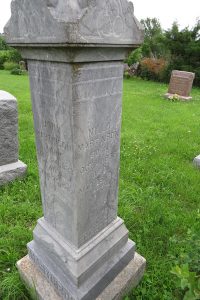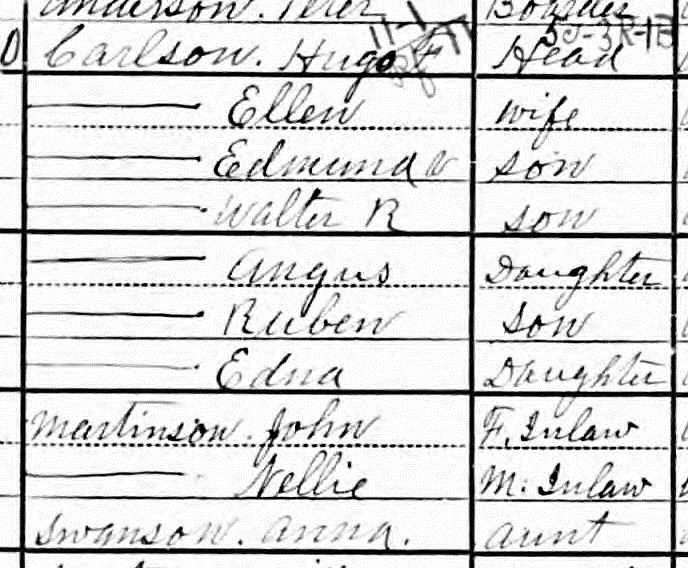In the last post on this topic, we looked at John Martinson’s estate inventory as prepared by his brother, Lars Martinson. In addition to the assets initially itemized by Lars, two other claims were submitted to the court. One by John’s daughter, Matilda, for a loan of money and another by John’s son-in-law Hugo Carlson for a mortgage. My guess is that these debts were unknown to Lars at the time he submitted the inventory. I think the usual process for adding onto an inventory that has already been filed would be to file a claim. I don’t think this should be viewed as a hostile or negative act but rather the normal process for making sure that the estate inventory is complete.
Next in the file we find a claim by John’s widow, Nilla Martinson. The laws at that time provided that if you died without a will, all of your assets would be equally divided among your heirs. An exception was provided for the widow, however. She could claim a certain portion of the estate first, and then the remainder after that would be equally divided. So someone apparently advised Nilla to file a claim against the estate for her entitlement as John’s widow. She claimed the following personal property:
- $50 cash
- one horse, value $45
- one cow, value $25
- one top buggy and harness, value $15
- carpenter tools, value $2.00
She was also entitled to an additional $100 for support and maintenance while the estate was being settled.
Her application was made on December 23, 1901 (about 11 months after John’s passing) and approved on the same date. Something I like about these probate records is that you can sometimes see actual signatures, and that is the case for Nilla’s application. Her handwriting looks very much like traditional Swedish script of the 1800’s. 
Next in the file is the final decree. This is where we see itemized lists of all the receipts and expenses since John died. I’m kicking myself now for not copying all of the receipts that were included in the court’s files. I understand now how valuable they can be in understanding how the debts get paid out. But no matter, there’s still a lot to see in the lists.
The final decree was signed on January 6, 1902. The decree listed all his heirs, unchanged from the original petition. His only real estate asset listed is the Section 24 farm. I’m thinking that by the time of the decree, the leased farm had been let go.
There are two itemized lists, Receipts (Exhibit A) and Expenditures (Exhibit C). (I’m guessing that Exhibit B is a designation for some other purpose not applicable to John’s estate.)
John died with a lot of people owing him money. Was Lars able to settle all those debts? Yes, it appears so. Couldn’t quite reconcile E. C. Hanson’s and Karl Odman’s accounts but the rest all makes sense.
| Owed by | Amount Owed | Amount Paid |
|---|---|---|
| A. G. Anderson | $117.20 | $128.90 |
| Karl Odman | $200 | $200 lease $350 note |
| Pete Hallberg | $150 | $150 |
| N. O. Pearson | $155 | $209.35 |
| Mrs. Augusta Engstrom | $350 | $365.75 |
| H. Hallberg | $375 | $432 |
| E. C. Hanson | $174.85 note $160.78 acc’t |
$182.10 note $50 acc’t |
| Andrew Carlson | $1260 | $1309.88 |
| H. F. Carlson | $300 | $300 |
The farms did well during 1901. Lars was able to sell various lots of oats, corn and wheat for a total of $1012.57.
John was also holding several mortgages. How about those – were they paid off?
| Owner | Location | Amount Due | Amount Paid |
|---|---|---|---|
| Swan Martinson | 80 ac – Sec 4 Twp 13 Rge 7 | $129 | $120.15 |
| Andrew Martinson | 160 ac – Sec 1 Twp 13 Rge 7 | $476 | $556.50 |
| Hugo Carlson | 160 ac – Sec 9 Twp 13 Rge 7 | $1800 | $2007.50 |
| Nels Martinson | 200 ac – Sec 8 & 17 Twp 13 Rge 7 | $3000 | $3330 |
| C. F. Mostrom | 160 ac – Sec 21 Twp 13 Rge 7 | $1429 | $1507.50 |
Some of the note and mortgage debts were settled right away, while others remained outstanding until December of 1901 with additional interest accruing during the interim period. I guess we’ll never know how much trouble it was for Lars to get everything collected. Had John not died, some of these debts might not have been due so soon. But it was probably Lars’ responsibility to call in all of John’s debts within a year. Some of these folks might have had to secure other financing in order to hold onto their farms, and that probably took some time.
As for John’s debts, he owed money to his daughter and to his son-in-law. These debts were also settled.
| Owed to | Amount Owed | Amount Paid |
|---|---|---|
| Matilda Martinson | $2622.33 | $2624.03 |
| Hugo Carlson | $1908.25 | $1919.21 |

As for John’s other expenses payable during the year, there were $138.22 in funeral expenses plus $120 for the beautiful stone monument (still standing in the Fridhem Cemetery). We also see tax payments due, payments to neighbors and friends for shelling corn and threshing and other miscellaneous farm expenses.
But a surprise turned up! The estate also paid funeral expenses and a monument for “Anna Svenson”. Who is this?
Searching on findagrave.com, I quickly found her grave. She was born on August 30, 1833 and died February 14, 1901. So she clearly died during the period that John’s estate was under Lars’ supervision. The spelling of her last name, Svenson, made me think of Nilla. I checked my records for Nilla and sure enough, she had a sister Anna born on August 30, 1833! I don’t know whether the ‘Swanson’ name refers to her married name or to an Americanized version of ‘Svensdotter’, but I have no doubt that this is Nilla’s sister. This a cool discovery, and now I’m curious whether any of Nilla’s other siblings came to the United States.
The 1900 census shows Anna living with John and Nilla at the home of Hugo and Elna Carlson. (That must have been quite houseful of inlaws for poor Hugo to deal with!) Anna is listed as a 66-year-old widow with four children still living, and she emigrated to the United States in 1889. I don’t know whether she came to this country before or after her husband died, or whether her children were in the U.S. or in Sweden. More digging to do on this one for sure!

After everything had been settled, John’s estate held about $9600 in cash plus the farm in Section 24. The cash would have been divided equally among his heirs. The little girls, Ruth and Mabel Hanson, were to split their mother Anna’s share of the estate. As I mentioned above, I didn’t bother with printing all the receipts but I assume included in them would have been receipts for these payouts. The final decree said that the real estate was “subject to the dower interest of Nilla Martinson”. I think that means she gets to keep it until she dies and then it passes to the other remaining heirs.
As I suspected all along, John Martinson did very well; he accumulated land and wealth as an early Saunders County homesteader. Someday I will go back to the Saunders County courthouse and track down all his land holdings to see if he really did acquire a farm for each one of his children.
This concludes my look at John Martinson’s probate records. Next up, Christian Pearson!

Thank you! Very interesting!
Lee Martinson
I’m Fred LeRoy Martinson, son of Fred L. Martinson, and grandson of Lars. I was “an after thought”, myyoungest sister being 10 years older than me. Since your digging found Lars to be 10 yrs younger than John, I’m curious about his siblings. Lee will check that out. I used to walk past John’s home each morning and night going to Dist 100 grade school for 8 years. One of John’s sons frightened us. I have no recollection of any thing happening to cause the fright, just remember it was there. Nothing occured beyond the fact we usually looked to see if he was around. John certainly did well in the USA You don’t say anything of John’s daughter Evelyn, that was quite handicapped. Was anything done to care for her after John’s death?